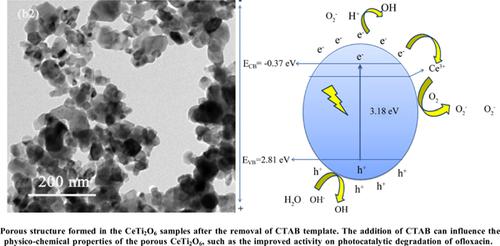Current Nanoscience ( IF 1.4 ) Pub Date : 2020-12-31 , DOI: 10.2174/1573413716999200511130328 Lili Yang 1 , Chuanguo Li 1 , Wenjie Zhang 1

|
Background: Photocatalytic oxidation of organic pollutants in the environment is being studied for more than half a century. Titanate has the activity on the degradation of organic pollutants under UV light illumination. Template directed sol-gel method is capable of producing porous structure in titanate during high temperature thermal treatment.
Methods: The materials were characterized using X-ray powder diffraction, transmission electron microscopy, scanning electron microscopy, surface area and pore size analyses, UV-Visible spectrometry, and Xray photoelectron spectroscopy. Photocatalytic activity of the CeTi2O6 material was evaluated through ofloxacin degradation.
Results: Brannerite structured CeTi2O6 was the major component in the samples, and the addition of CTAB caused a slight growth of CeTi2O6 crystals. Porous structure formed in the porous sample after the removal of CTAB template, and the surface area and pore volume were greatly enlarged. The first order reaction rate constant for photocatalytic degradation of ofloxacin was 9.60×10-3 min-1 on the nonporous CeTi2O6 sample, and it was as large as 2.44×10-2 min-1 on the porous CeTi2O6 sample. The addition of CTAB can influence the physico-chemical properties of the porous CeTi2O6, such as the improved activity on photocatalytic degradation of ofloxacin.
Conclusion: The CeTi2O6 samples composed of majority brannerite CeTi2O6, and CeTi2O6 crystallite sizes for the nonporous and porous samples were 38.1 and 43.2 nm. The burning up of CTAB during calcination produced abundant pores in the porous material. After 50 min of reaction, photocatalytic degradation efficiencies on the nonporous and porous CeTi2O6 samples were 38.1% and 70.5%.
中文翻译:

多孔CeTi 2 O 6光催化剂-CTAB诱导的孔隙度提高了氧氟沙星的降解效率
背景技术:研究环境中有机污染物的光催化氧化已有半个多世纪了。钛酸酯具有在紫外线照射下降解有机污染物的活性。模板定向溶胶-凝胶法能够在高温热处理过程中在钛酸酯中产生多孔结构。
方法:使用X射线粉末衍射,透射电子显微镜,扫描电子显微镜,表面积和孔径分析,紫外可见光谱和X射线光电子能谱对材料进行表征。通过氧氟沙星降解评估了CeTi 2 O 6材料的光催化活性。
结果:褐铁矿结构的CeTi 2 O 6是样品中的主要成分,而CTAB的加入导致CeTi 2 O 6晶体的轻微生长。去除CTAB模板后,在多孔样品中形成多孔结构,表面积和孔体积大大增加。氧氟沙星的光催化降解的一级反应速度常数为9.60×10 -3 min-1的上无孔CETI 2 ö 6样品,并且它是大到2.44×10 -2分钟-1上的多孔CETI 2 ö 6样本。CTAB的添加会影响多孔CeTi 2 O 6的物理化学性质,例如氧氟沙星对光催化降解的活性提高。
结论:CETI 2个ö 6多数brannerite CETI构成样品2 ö 6,和CETI 2个ö 6微晶尺寸为无孔和多孔样品38.1和43.2纳米。煅烧过程中CTAB的燃烧在多孔材料中产生大量孔。反应50分钟后,无孔和多孔CeTi 2 O 6样品的光催化降解效率分别为38.1%和70.5%。











































 京公网安备 11010802027423号
京公网安备 11010802027423号